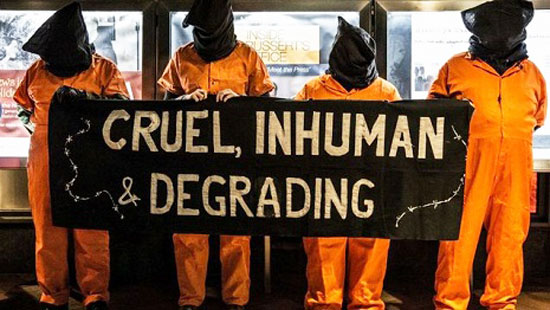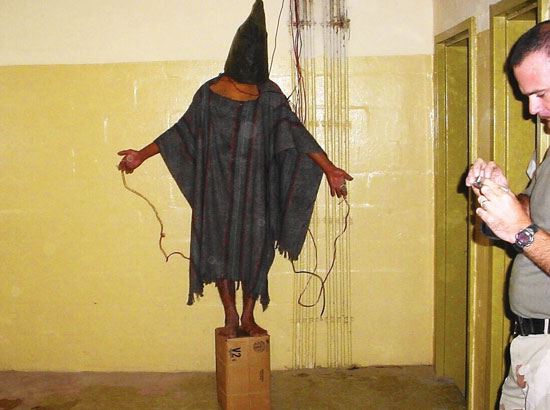The secret CIA torture program that has just come to light (3)
Read the second part of the article
Using “Quality Control” as a Way to Skirt Federal Laws Regarding Experiments on Prisoners

Anxiety over being charged with violation of Federal laws regarding experiments on prisoners arose again when the CIA Inspector General pressured OMS to conduct “effectiveness” studies on “each interrogation technique and environmental deprivation”.
According to the OMS document, in May 2004 the CIA Inspector General, “noting the uncertainty about the effectiveness and necessity of individual EITs, formally recommended that the DDO [Deputy Director of Operations], together with OMS, DS&T [Department of Science and Technology] and OGC [Office of General Counsel], ‘conduct a review of the effectiveness of each of the authorized EITs and make a determination regarding the necessity for the continued use of each, including the required scope and duration of each technique’. Outside representation was to be included on the review team”.
OMS complained they did not have “sufficient outcome data to make this assessment and that were the data provided there needed to be some written assurance that a ‘study’ of this sort would not violate Federal law against experimenting on prisoners.”
Of all people, James Mitchell and Bruce Jessen came to OMS’s defense, arguing that it was impossible to quantify effectiveness in the way the CIA IG wanted. They saw interrogation as an art, more than a science. Of course, others would see their version of interrogation as torture.
“In this process”, they wrote, “a single physical interrogation technique is almost never employed in isolation from other techniques and influence strategies, many of which are not coercive. Rather, multiple techniques are deliberately orchestrated and sequenced as a means for inducing an unwilling detainee to actively seek a solution to his current predicament…”
Instead, the Chief of OMS, who indicated there were only 29 EIT “cases” up to that point, maintained that an effectiveness analysis could be considered a matter of “quality control rather than human subjects research”. While such “analysis… would be rather limited. Nonetheless, insights were considered likely to emerge.”
In other words, hypotheses about effectiveness were to be established and proved or disproved. The effectiveness research, labeled “quality control” would have amounted to an illegal program of human experimentation, and OMS was acutely aware they were crossing or about to cross a very serious line.
Adhering to the fig leaf of “quality control” RDI “proposed in early 2005 that an internal review be undertaken by a small team composed of a senior person from the Counter Intelligence Center, the recently retired [short redaction] Medical Services, and possibly a psychiatrist.”
But this small team was never assembled. Instead, the CIA Inspector General dropped the idea of a “blue ribbon” review, and proposed an entirely outside panel that would examine the effectiveness of the EITs.
This aspect of the story was reported back in 2009 in most of its particulars by Greg Miller at the Los Angeles Times. What Miller didn’t know or understand was that the question of judging effectiveness of the program immediately raised ethical issues around research on prisoners.
Two outsiders, Gardner Peckham (an adviser to Newt Gingrich) and John Hamre, Deputy Defense Secretary in the Clinton administration and President and CEO of the important Washington think tank, Center for Strategic and International Studies, were picked for the job.
Both Peckham and Hamre “endorsed the RDG program”. Both found it difficult to assess techniques objectively. Peckham recommended keeping the waterboard. Hamre noted that the most effective techniques seemed to him to be the “conditioning EITs (sleep deprivation, dietary manipulation)”.
Hamre also concluded: “the data does suggest that EITs, when incorporated into a comprehensive program based on sound underlying intelligence and analysis, did provide useful intelligence products.”
A Program of “Applied Research”
“RDI” or “RDG” or whatever its different names, always referred to a separate, highly classified program under the auspices of the CIA’s Counter Terrorism Center’s Special Mission Division (CTC/SMD). This program was experimental in nature and consisted of scientifically developing a set of brutal interrogation techniques derived from the military and CIA’s own torture survival training programs.
The development of these “enhanced” set of techniques, which included waterboarding and a complex form of extended sleep deprivation, was the work of the CIA’s Office of Technical Services. When former military psychologists James Mitchell and Bruce Jessen joined the RDI unit, they were initially tasked as contract employees for OTS to work on research-related issues.
In an important 2016 article by Greg Miller in the Washington Post, which also posted the non-classified CIA contracts for Mitchell and Jessen, it was revealed that James Mitchell, identified in an investigation by the Senate Select Committee on Intelligence (SSCI) as a chief architect of the CIA’s torture program, was first hired by CIA’s OTS before 9/11.
Mitchell’s initial contract was to “identify reliable and valid methods for conducting cross-cultural psychological assessments” and to “identify the current state of behavioral science on theories and methods for influencing attitudes, beliefs, motivation and behavior” particularly from individuals from “non-Western countries”.
After 9/11, at latest by December 2001, Mitchell’s contract changed, and his job now was to “guide” his employer, the name of which was redacted in the document but was likely OTS or CDC/RDI, in shaping “the future direction of Sponsor’s applied research effort”.
Mitchell was also to provide “consultation… regarding applied research in high-risk operational settings… applying research methodology to meet mission goals and objectives” for OTS.
What these “mission goals and objectives” were are unknown, but if revealed, would bring us to the heart of the OTS-inspired “enhanced interrogation” torture program.
Mitchell also was to conduct “specified, time-limited research projects” as identified by his employer. As referenced in the SSCI report, Mitchell discussed his approach and his background in a memo, February 1, 2003, “Qualifications to provide special mission interrogation consultation”.
Despite contentions by a number of observers and the Senate Intelligence Committee report that Mitchell had no interrogation training, according to his document, he received interrogation training at JPRA SERE Psychology conferences, including a “multi-day course with laboratory”. By February 2003, he had more than 550 hours of experience (hut time) interrogating or debriefing known terrorists.
The entire question of illegal research on “war on terror” detainees remains largely unaddressed in mainstream accounts on the torture scandal.
In the past, alternative media have documented discussions regarding research on detainees from a number of different sources, as also published in the book Cover-up at Guantanamo. Some of these discussions among government linked contractors involved the importance of being “read in” to the classified research programs.
Many Questions

The realization that the CIA program was actually two different, though associated, programs means that much of what we know or believe we know about use of CIA torture needs to be reexamined.
For instance, how exactly did the use of rendition differ between the two programs, if it did at all? Were foreign intelligence programs, or portions of them, “read into” the RDI program and involved in any aspect of the calibration of the torture techniques by CIA?
Or what about the fact that CIA director Gina Haspel was tasked in 2002 to run a prison involved in the RDI program? Questions that should have been asked during her confirmation hearing about the use of illegal experimentation on CIA prisoners were never asked.
The most salient question is why have two different programs at all? This question is open to far-reaching analysis, but at least one functional aspect was to make it harder to determine what was going on in both of the programs.
The many issues regarding illegal experimentation brought up by OMS personnel raise pressing questions about the nature of the CIA’s entire operation. The conflation of the two different programs into one CIA program has served to obfuscate the experimental nature of the singular RDI program.
In June 2017, Physicians for Human Rights published a report, authored by Dr. Scott Allen, demonstrating that the CIA’s post-9/11 torture program constituted a regime of illegal human experimentation.
The PHR report corroborates the argument, as contained in this article, that the CIA was involved in illegal experiments, and knew they were in violation of the law. The report also describes how the CIA violated the strictures on experimentation.
But the report fails to note the key role of the OTS or the RDI group, nor does it seem to understand that two bureaucratically separate torture programs were at work. It is one goal of this article to spur action by Congressional investigators or other proper authorities regarding PHR’s revelations about CIA’s illegal human experimentation.
There are many other questions. For instance, what did it mean that at times the two programs shared personnel, as when Mitchell and Jessen were involved in the interrogation of Gul Rahman at the Salt Pit prison?
The supposedly more regulated aspect of the RDI program did not mean that it was free of “improvisations” or “excesses” beyond the DoJ-approved interrogation/torture techniques. In particular, the OMS report comments on the brutal treatment of accused high-level detainee, Abd al-Rahim al-Nashiri, the so-called “mastermind” of the bombing of the USS Cole.
According to the Chief of OMS, al-Nashiri was a “target” of early “excesses” by RDI staff, supposedly because his “immaturity regularly provoked” them.
As a result, at one point an OMS physician assistant had to intervene in al-Nashiri’s interrogation to prevent abuse. At other times, when the physician assistant and interrogation team were absent, a “debriefer” hooded al-Nashiri, and threatened him with a gun and a drill.
The OMS Chief tersely noted of this interrogator: “He was disciplined”.
The ramifications of the CIA having two torture programs needs to be addressed by all commentators. For instance, while the famous John Yoo and Stephen Bradbury torture memos are understood as having authorized the CIA’s “enhanced interrogation” or RDI program, the question remains as to who or what authorized the CTC program at non-RDI black sites. Did OLC authors understand they were legitimating a highly covert and compartmentalized operation?
In the end, it is worth mentioning that a conflict arose between OTS and OMS in the administration of the RDI program, and OMS contended with issues surrounding medical ethics, “dual loyalties” among medical personnel, and the criticisms of external “activists” about the EIT torture program.
yogaesoteric
February 9, 2019
